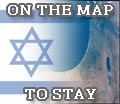With reference to this post’s title, I am not using the term “drinking in the Holy Land” in the metaphorical sense, as in “we spent two weeks drinking in the sights and sounds of Israel,” despite its appropriateness when deployed in that manner.
Nope.
I’m talking about the Ingestion of Fluids, both of the alcohol-bearing sort and, well, the other kind. For if you’re planning to spend time in the Middle East in July, you’d best be prepared to do some serious hydration. It gets hotter than a brass monkey’s nutsack in many of the places we traveled to - hell,
all of the places we traveled to - in the height of summer. Liquid refreshment is your friend.
Our tour bus driver thoughtfully provided a chilled compartment stuffed with bottles of water. At a buck a throw, it was a nice side business for him, and a way for those of us who had neglected to top up our supplies to keep up with our moisture requirements without having to wait for mealtimes or rest stops. We drank water by the pint - by the quart, by the
gallon - every chance we got, and would immediately sweat it right out. Thank Gawd for modern wicking fabrics, which prevented us from devolving into a stinking, dank mob.
I have spoken before about how breakfast is an Art Form in Israel, but it is by far not the only prosaic edible or potable to be so elevated. Take, for instance, the humble glass of lemonade. Here in the States, it’s the province of prepubescent entrepreneurs, but in Israel it’s a thing of beauty - mainly because it’s jacked up with mint. Presenting... limonana!
 Limonana - lemonade and mint - may very well be the Israeli national beverage.
Limonana - lemonade and mint - may very well be the Israeli national beverage.
“Limon” is pretty self-explanatory: Lemons are plentiful in Israel (unlike limes, which, strangely, were nowhere to be seen during our visit). “Nana” is Hebrew for mint. Take a generous wad of mint leaves, steep them in your lemonade, run the whole mess through a blender (if desired), and you’ve got limonana. Depending on where you find it, the balance of mint to lemon can vary, from almost straight lemonade to something that some might say tastes like the bastard child of a lemon and a bottle of Scope. I actually preferred the mintier versions, such as the one in the photograph above.
Soft drinks were plentiful, of course. It was easy enough to find Coke Zero (and its local evil twin, Pepsi Max), although Cheerwine and IBC Root Beer were thin on the ground.
 JoAnn and SWMBO say, “Have al-Coqaida and a smile. And a bowl of hummus and some felafel.”
JoAnn and SWMBO say, “Have al-Coqaida and a smile. And a bowl of hummus and some felafel.”
Coffee is popular in Israel, too. On hot days (
i.e., pretty much
every frickin’ day), you could get a “cold coffee,” which was coffee and milk over ice. Or you could get an “ice coffee,” which had been run through a freezing gizmo to convert the coffee-milk mixture into something resembling a slushy. For us hardcore caffeine hounds, espresso was plentiful, along with the ubiquitous Turkish coffee. This latter is finely pulverized coffee that is boiled once or (preferably) twice, sweetened to diabetic coma levels, and served in tiny cups. A properly made Turkish coffee contains a roughly 50:50 proportion of muddy grounds to liquid and is screamingly caffeinated. The Arab version, infused with cardamom, is my personal favorite.
And then there were the Adult Beverages.
During our stopover in New York enroute to Tel Aviv, we took the precaution of purchasing a couple of bottles of strong Brown Goods. The selection at the duty-free shop was not the best (unless you had a jones for über-pricey items like Johnnie Walker Blue), but there was a fine Glenmorangie LaSanta with my name on it, and likewise a Bowmore 12-year-old Islay malt that called out to my friend Barry. And the prices were reasonable, especially considering the fact that you were getting a full liter instead of the usual 750 ml load. Thus it was that we were well provisioned when our group’s impromptu cocktail parties would convene at seven every evening.
Israel produces a handful of excellent beers and an ever-increasing number of fine wines, the latter competitive with the best of France and California. The Hard Stuff is another story, however. Israeli spirits run
mainly to a few brandies, along with arak (an anise-flavored cousin to Greek ouzo). While I generally like to rely on local products, arak is not exactly the ideal base for mixed drinks - for those, you’d have to go to the Imported Booze well. The hotel bars could be trusted to make simple cocktails, but anything complicated (like, say, an extra dry gin Martini) would, like as not, require special instructions and hand-holding. So I was glad for those bottles of duty-free Scotch whisky, which lasted the better part of
two ten days.
Hmmm. I wonder what limonana would taste like with a handsome tot of gin in it?









